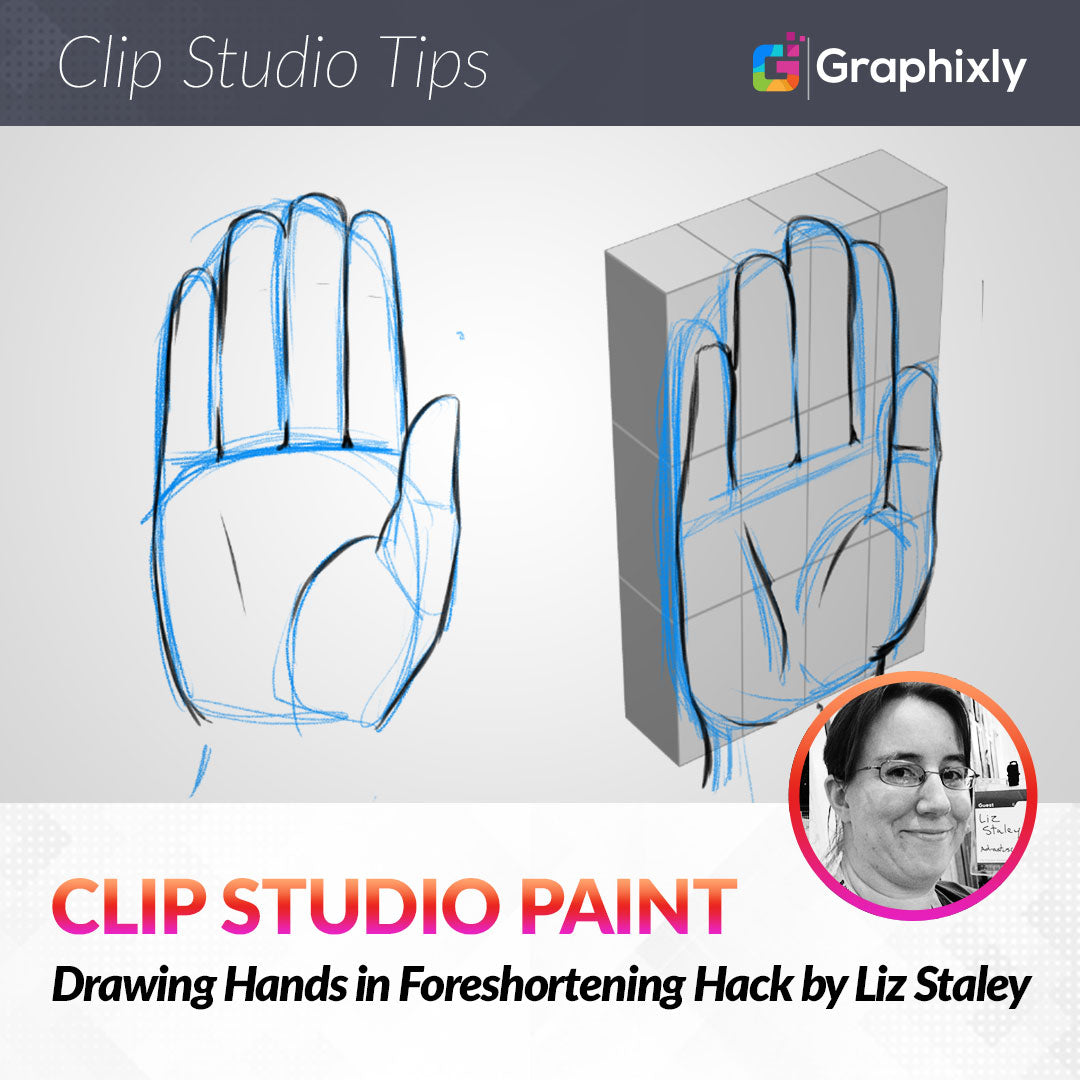
Drawing Hands in Foreshortening Hack
Contact Graphixly @
Hello! My name is Liz Staley and I’m a long-time user of Clip Studio Paint (I started using the program back when it was known as Manga Studio 4!). I was a beta-tester on the Manga Studio 5 program and for Clip Studio Paint, and I have written three books and several video courses about the program. Many of you probably know my name from those books, in fact. I write weekly posts on Graphixly.com and on CSP Tips, so be sure to come back every week to learn more Clip Studio Tips and Tricks from me!
I’m sure that the “hack” in this tip is nothing new, but I thought it might be helpful to someone who has trouble drawing hands in different angles. I think if you have issues with conceptualizing the perspective but don’t want to use 3D hand models, this might be a helpful tip.
In this article we will cover the following topics:
Using Primitives to help foreshorten the hand
Let’s get drawing!
Using Primitives to Help Foreshorten the Hand
For this tip I’m going to be using a 3D primitive to help with imagining a hand in various angles of foreshortening. Foreshortening is a technique that simulates how we perceive an object receding in space. You know those cool manga panels where a character’s fist looks like it’s coming right for your face? That’s one example of foreshortening! Sometimes foreshortening is exaggerated, like the hand in the image below.

Or it can be a bit more subtle, such as the right leg in the drawing below.

Foreshortening can be applied to anything that we draw that we want to look like it’s coming forward or moving away in space. It’s a visual trick that artists employ to mimic 3D space in the 2D format of a drawing. In this article we’re just going to concentrate on a quick way to visualize a hand in 3D space and help us draw it a little easier.
To start, we’re going to need a cube primitive. These can be found in the Materials Library, under 3D - Primitive. Select the Cube and add it to your drawing canvas.

Now obviously a cube is not hand-shaped, so we’re going to have to change that! I use the Operation - Object tool and click on the Cube Primitive to select it. When selected, you will see a set of controls that look like the screenshot below.

The pink, green, and blue squares allow us to change the scale of the primitive along one axis at a time. If we think about a hand’s general shape, what we actually need is a rectangle that isn’t too deep to get the general shape of a hand. I made a tall, slightly-skinny rectangle out of the cube primitive, then sketched a basic hand to check the proportions.
It’s okay to continue to change up this primitive as we move it around, this is really just a guide to help us imagine the hand shape in a 3D space!

I was pretty happy with this rectangle at this angle, but decided to check the proportions of it from another angle as well. Below you can see the original sketch from the image above, but I’ve moved the primitive over to the side and turned it slightly so I can do another hand sketch in a new angle.

Using the divisions on the primitive as guides, try to draw the same hand pose at the new angle. Don’t forget to take depth into account. For instance, in the drawing below I probably should have moved the hand further back in the line of the primitive so that the leftmost line of the hand was on the back line of the 3D shape. That would make the hand have a bit more volume than what I ended up with, but this was a learning experience as I was doing it!

For a final challenge, I wanted to see if I could really push this and do some pretty extreme foreshortening. So I rotated the primitive around until I came up with an angle I liked.

At this angle, the fingers will be coming toward the viewer and we really need to pay attention to the volume of the shapes. Fingers are long cylinders, so I drew some ‘coils’ coming forward to help imagine the thickness and shape of the fingers while using the divisions on the cube to help with the angles and perspective.

With a few practice sketches I felt like more of a challenge so I tried a more delicate and subtle hand and I feel like it came out pretty well! Using the primitive as a guide helped with “seeing” the perspective a bit, making it easier to get the angle of the palm and the fingers right to make the drawing more convincing.

Conclusion
I’m sure that I’m not the first person to have this idea, but maybe you’ve never seen this before and it’s just what you needed to help with visualizing angles for your hand drawings! I hope that this tip is a little helpful to someone out there who needs it.
For more information on CLIP Studio Paint, please visit https://www.clipstudio.net/en or https://graphixly.com